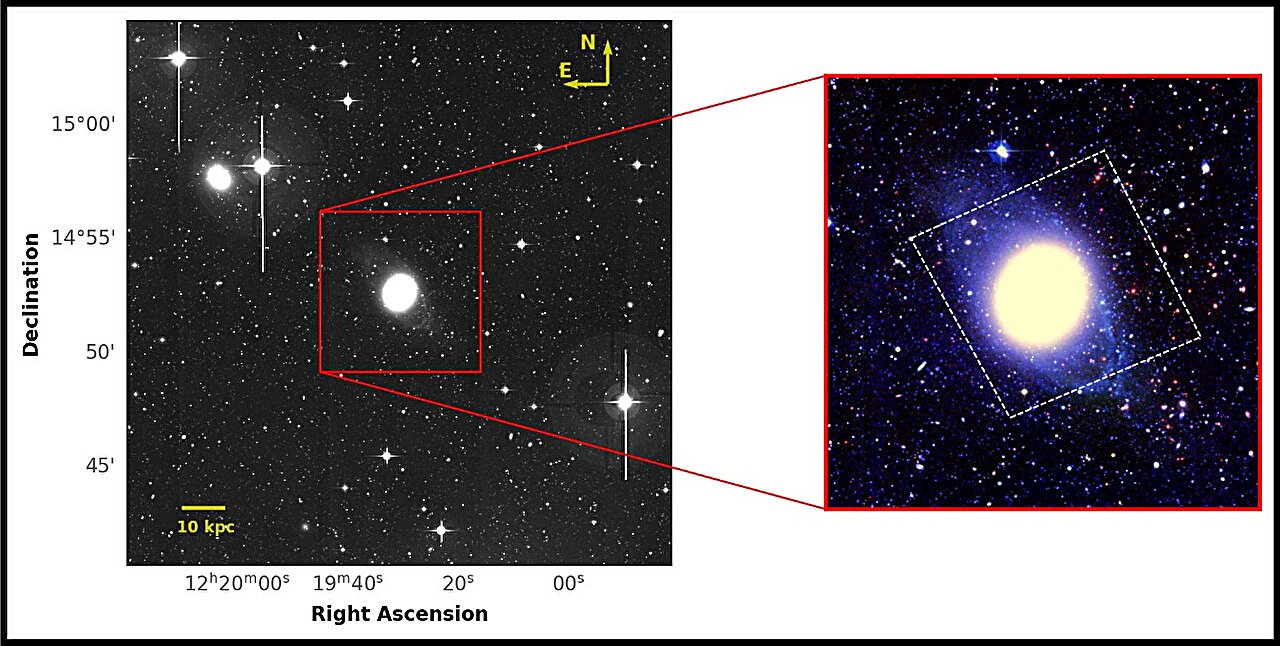Using the Canada-France-Hawaii Telescope (CFHT), Indian astronomers have performed wide and deep field observations of a polar ring galaxy known as NGC 4262. Results of the observational campaign, published April 15 on the pre-print server arXiv, shed more light on the globular cluster system of this galaxy.
The so-called polar ring galaxies (PRGs) are systems composed of an S0-like galaxy and a polar ring, which remain separate for billions of years. In general, these outer polar rings, composed of gas and stars, are aligned roughly in a perpendicular orientation with respect to the major axis of the central host galaxy.
At a distance of some 50.5 million light years, NGC 4262 is the nearest PRG to Earth and a member of the Virgo cluster. It is a gas-rich galaxy with an apparent magnitude of approximately 12.49 mag.
Although many studies of NGC 4262 have been conducted, its globular cluster system (GCS) remains unexplored. That is why a team of astronomers led by Akhil Krishna R of Christ University in Bangalore, India, has employed CFHT’s MegaCam instrument to investigate the GCS in this galaxy. The observations were carried out as part of the Next Generation Virgo Cluster Survey (NGVS).
“This study extensively investigated the GCS properties of the PRG NGC 4262 using the wide-field optical images obtained from the Canada-France-Hawaii Telescope,” the researchers wrote.
The astronomers obtained the first optical image of NGC 4262 featuring an optically faint ring component. The images show that NGC 4262 has a bar structure within a 20-arcsecond radius and a polar ring structure after a 50-arcsecond radius from the galaxy’s center.
The observations found that the GCS of NGC 4262 contains at least 266 globular clusters with an extent reaching 124,000 light years. The total mass of the system was calculated to be 63.8 million solar masses.
Based on the analysis of the radial distribution of GCS in NGC 4262, the astronomers found a color gradient of -0.05 within 5.5 arcminutes, transitioning to a flattened profile beyond this radius. This finding points to past interactions within NGC 4262 and a shift from dissipative to dissipationless mechanisms in the evolutionary history of the galaxy’s GCS.
The spatial and azimuthal distributions of stellar subpopulations further confirm past interactions within NGC 4262, given that a slight deviation has been observed in the radial and azimuthal angle distribution of the GCS.
The study also found that NGC 4262 has a specific frequency of 4.2 and a specific mass of 0.23. According to the researchers, this is relatively high when compared to other galaxies of similar mass and in similar environments.
Summing up the results, the authors of the paper concluded that their findings indicate a transition phase between spiral and elliptical galaxy for NGC 4262.
“The high specific frequency of NGC 4262 holds a position close to ellipticals, suggesting that the GCS properties of PRGs are more similar to those of elliptical galaxies than spiral galaxies. All these results indicate the probability of NGC 4262 becoming an elliptical galaxy and currently being in a transition state based on its GCS properties,” the scientists explained.
More information:
Akhil Krishna R et al, Beyond the Rings: Polar Ring Galaxy NGC 4262 and its Globular Cluster System, arXiv (2024). DOI: 10.48550/arxiv.2404.10059
© 2024 Science X Network
Citation:
Observations explore globular cluster system in the galaxy NGC 4262 (2024, April 23)
retrieved 23 April 2024
from https://phys.org/news/2024-04-explore-globular-cluster-galaxy-ngc.html
This document is subject to copyright. Apart from any fair dealing for the purpose of private study or research, no
part may be reproduced without the written permission. The content is provided for information purposes only.

